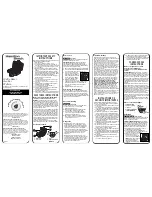
Copies of the I/B. Please reproduce them without any
changes except under special instruction from Team
International BELGIUM. The pages must be reproduced
and folded in order to obtain a booklet A5 (+/- 148.5 mm
width x 210 mm height). When folding, make sure you
keep the good numbering when you turn the pages of
the I/B. Don’t change the page numbering. Keep the
language integrity.
10
TKG BBA 2 – 080514
Assembly page 10/44
Fax +32 2 359 95 50
WATER TANK (8)
Your appliance is equipped with a water tank of 200ml on the right-hand side. To fill the water
tank, pull it out of the appliance and unscrew its cap. Fill it with water but do not exceed the
maximum level indicated on the water tank (“FULL”). Screw the cap back on and put the
water tank back in the appliance.
You can only use the steam feature if there is a sufficient amount of water in the water tank.
USE AS A BREADMAKER
Temperature
All ingredients that you pour in the bread maker should be at an ambient temperature. The
room where you use the appliance should be at a temperature between 15°C and 34°C, and
ideally between 20 and 23°C. The room temperature has an influence on the loaf size.
Measuring the ingredients
Your appliance is equipped with a combined graduated spoon (small and large).
When talking about "cup" in this instruction manual, it refers to one measuring cup supplied
(250 ml).
On the combined graduated spoon, you'll see the following marks:
Tablespoon (tbs) = 15 ml
Teaspoon (tsp) = 5 ml
To measure liquid ingredients, fill the measuring cup and place it on a flat surface. The
liquid level line must be aligned to the mark of measurement. An approximate
measurement is not sufficient and could have a bad influence on the balance of the
recipe.
To measure the flour lightly spoon it into the measuring cup and once filled, level off with a
straight-edged utensil. Scooping or tapping a measuring cup will pack the flour and you
will end up with more than is required. This extra amount could affect the balance of the
recipe. Do not sift the flour. To measure small amounts, use the graduated spoon and
make sure it is level, not heaped. For some dry ingredients such as raisins or chocolate
chips, we advise you to use a kitchen scale.
Geographic situation
At altitude above 3,000 feet, flour tends to be drier and absorbs less liquid. Slightly more liquid
or less flour may be required.
Dough rises faster at higher altitude. Either sugar, yeast or liquid should be adjusted slightly to
prevent over-rising. See table below for guidelines.
ALTITUDE
Adjustment
3,000 ft
5,000 ft
7,000 ft
Reduce yeast: For each tsp in the recipe, decrease by
1/8 tsp
1/8 – 1/4 tsp + 1/4 tsp
Reduce sugar: For each tbs in the recipe, decrease by
0-1 tsp
0-2 tsp
1- 2 tsp
Increase liquid: For each cup in the recipe, add
1 -2 tbs
2-4 tbs
3-4 tbs
Ingredients
One of the most important factors involved when making bread is the quality and freshness of
the ingredients. Moreover, it is absolutely necessary to follow the amounts prescribed
accurately.











































